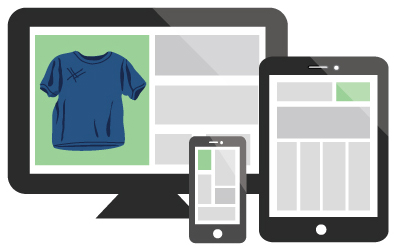Picture your closet; inside is an array of shirts from throughout the years. Some fit great, but others are too small, worn-out, or have holes in them. You wouldn’t even consider wearing the shabby, worn-out shirt in public anymore. However, you originally purchased these garments for a couple reasons: (1) its functionality and (2) its visual appeal.
Responsive design – the idea that a website should adapt and perform optimally on different media platforms – creates the same type of behavior in people. Consumers are shuffling through the “web-closet” of sites, ignoring the ones that are frustratingly difficult to navigate, while spending more time with the polished, eye-catching site that not only “wears” well on their iPhone screen, but delivers the information they desire. Whether it’s a tablet, computer, or smartphone, audiences are viewing company websites and marketing emails on an assortment of devices. So what does this mean for businesses?
- A user-friendly website that creates a positive customer experience is vital. Considering 61% of customers who visit an unfriendly site are likely to go to a competitor’s page, it’s important to create great user experience. For instance, take a look at Google. Their landing page design is simple and the function is clear. Whether people are on their iPhone or computer, the site translates the same across all platforms making it easy to view content. Not only is the site simple to navigate, but the animated Google doodles are also fun, engaging, and something to look forward to.
- Responsive design increases open rates. In terms of email marketing, a responsive design has the ability to be more engaging and thus increases audience interaction with emails. People are more likely to open up an email that’s as consistent on their phone as it is on their computer. This proves true as emails that incorporated mobile-friendly responsive design experienced a 21% higher click-to-open rate compared to non-responsive ones.
- A responsive design has the ability to increase conversion rates. Websites that incorporated responsive design have obtained the ability to keep customers exploring its pages for longer periods of time. In return, more people are taking a desired action and purchasing products online. E-commerce clothing store, O’Neill clothing saw their conversion rate for the iPhone increase an incredible 65.71% after implementing responsive design.
With visits expanding among a number of different media platforms, it’s important to implement a design that can “wear many hats” (or adapt to various technology platforms). People are drawn to visual sharpness and navigability, but the way a company’s website presents itself also drives consumer perceptions regarding the quality of the brand. In short, responsive design assists a business in getting its online marketing materials and website better noticed and utilized rather than ignored. After all, no one wants to be the shabby old t-shirt in the dusty corner of the closet.


Pingback: 4 Tips to Brighten Your Holiday Campaign | Right On Interactive